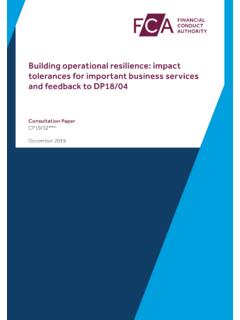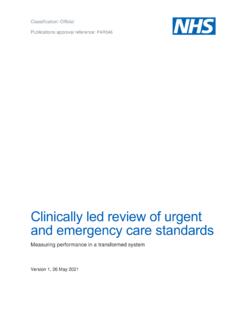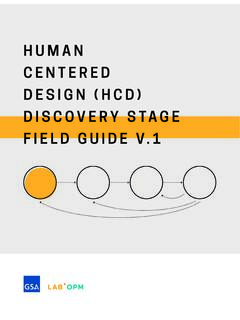Transcription of Transforming Public Procurement: Government response to ...
1 Transforming Public Procurement: Government response to consultation Date of Publication: December 2021 CP 556 Transforming Public Procurement: Government response to consultation Presented to Parliament by Paymaster General by Command of Her Majesty December 2021 CP 556 Crown copyright 2021 This publication is licensed under the terms of the Open Government Licence except where otherwise stated.
2 To view this licence, visit Where we have identified any third party copyright information you will need to obtain permission from the copyright holders concerned. This publication is available at Any enquiries regarding this publication should be sent to us at ISBN 978-1-5286-3014-6 E02691536 12/21 Printed on paper containing 75% recycled fibre content minimum Printed in the UK by HH Associates Ltd. on behalf of the Controller of Her Majesty s Stationery Office 1 Contents Overview .. 3 Introduction .. 3 consultation process .. 3 Breakdown of responses .. 4 Key themes .. 6 Next Steps .. 8 Devolved Administrations .. 9 Government response .
3 10 Chapter 1: Procurement that better meets the UK s needs .. 10 Chapter 2: A simpler regulatory framework .. 16 Chapter 3: Using the right procurement procedures .. 21 Chapter 4: Awarding the right contract to the right supplier .. 29 Chapter 5: Using the best commercial purchasing tools .. 46 Chapter 6: Ensuring open and transparent contracting .. 50 Chapter 7: Fair and fast challenges to procurement decisions .. 55 Chapter 8: Effective contract management .. 63 2 3 Overview Introduction 1. In December 2020, the Cabinet Office set out proposals for shaping the future of Public procurement legislation with the publication of a Green Paper, Transforming Public Procurement1.
4 The overarching goals of these proposals are to speed up and simplify our procurement processes, place value for money at their heart, generate social value and unleash opportunities for small businesses, charities and social enterprises to innovate in Public service delivery. 2. At around 300 billion2, Public procurement accounts for around a third of all Public expenditure every year. By improving the way Public procurement is regulated, the Government can not only save the taxpayer money but spread opportunity, improve Public services, empower communities and restore local pride across every region of the country.
5 A procurement regime that is simple, flexible and takes greater account of social value can play a big role in contributing to the Government s levelling-up goals. 3. Procurement reform is not new but it has always had to work within the framework of EU based regulations. The latest EU Directives were transposed into UK law in 2015 and 2016. Following the UK s exit from the EU, we now have an opportunity to develop and implement a new procurement regime, moving away from the complex EU rules-based approach that was designed first and foremost to facilitate the single market and instead adopt a new simplified approach that prioritises boosting growth and productivity in the UK, maximising value for money and social value, promoting efficiency, innovation and transparency.
6 4. The Green Paper sought feedback from stakeholders who will be involved in the new regime. This document summarises the feedback received to the consultation and provides the Government s response to each individual question. We have considered carefully all of the comments received . In some instances, there is no change to the proposals set out in the Green Paper; in others the Cabinet Office has clarified or amended the proposals based on the feedback . Details are set out under the response to each of the consultation questions, however these all remain subject to change as we work to finalise the new procurement regime.
7 consultation process 5. In developing the proposals for the Green Paper, Cabinet Office officials engaged with over 500 stakeholders and organisations through many hundreds of hours of discussions and workshops. This included stakeholders from central and local Government , the education and 1 2 Combined figure of gross current procurement ( 220,428 million) and gross capital procurement ( 71,583 million) from the Public Expenditure Statistical Analysis (PESA) 2019 4 health sectors, small, medium and large businesses, charities and social enterprises, academics and procurement lawyers.
8 6. The Public consultation on the Green Paper opened on 15 December 2020 and closed on 10 March 2021. 7. The Green Paper was circulated to a range of stakeholders and was also made available publicly on the website at the commencement of the consultation in December 2020. The Cabinet Office ran a series of open workshops in early 2021 for Public bodies, suppliers and other stakeholders aimed at providing an in-depth understanding of the proposals and to encourage interested parties to respond to the consultation . These workshops were attended by over 600 representatives from contracting authorities and over 300 stakeholders from suppliers, industry bodies and other interested parties.
9 8. The Cabinet Office has now analysed the consultation and what follows is a detailed review of the responses received . The Cabinet Office is grateful to all those who took the time to respond and for their help in developing the proposals. Breakdown of responses 9. In total, 619 responses to the consultation were received . There was a mix of responses between contracting authorities who will be responsible for procuring within the future regime and suppliers to the Public sector who will be bidding in procurements and delivering under contracts under the proposed regime. There were 226 responses from contracting authorities, 269 from suppliers and 124 from other interested parties such as academics, legal professionals and members of the Public .
10 Chart 1 - Responses by respondent category 10. Of the 226 responses from contracting authorities, almost half of these were from local Government . There were 32 responses from central Government departments as well as representation from housing associations, educational institutions and NHS Trusts. 5 Chart 2 - Contracting authorities by type 11. Of the 269 responses from industry, there was strong representation from SMEs and VCSEs3. There were 21 responses from the Government s strategic suppliers4. There were 44 responses from the utilities sector. Chart 3 - Responses from industry 3 SME means Small and Medium Enterprise and is generally defined as an organisation with fewer than 250 employees.


















